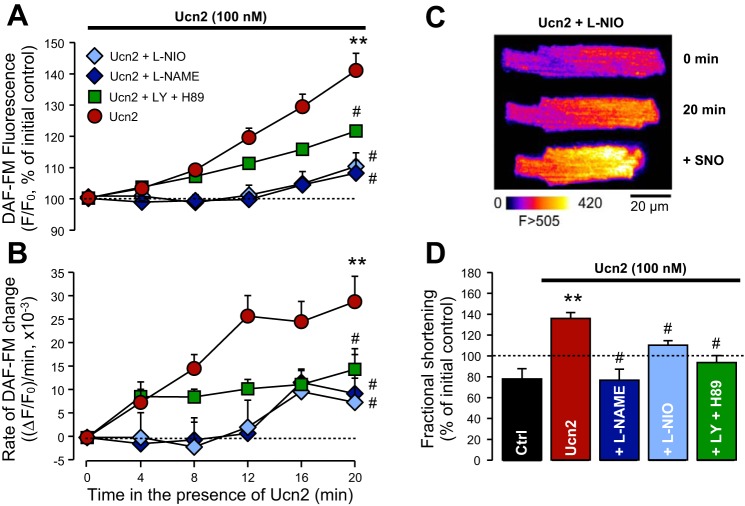Fig. 8.
eNOS as well as phosphatidylinositol 3-kinase (PI3K) plus PKA inhibition attenuate the urocortin 2-induced increases in NO production and fractional shortening. A: DAF-FM fluorescence changes during Ucn2 application (100 nM, red circles; n = 20; same cells as in Fig. 6) in the absence and presence of NG-nitro-l-arginine methyl ester (l-NAME; 1 mM, blue diamonds, n = 4), l-N5-(1-iminoethyl)ornithine (l-NIO; 10 μM, light blue diamonds, n = 8), and LY294002 plus H89 (10 and 1 μM, respectively, green squares, n = 10). B: rate of change of DAF-FM fluorescence. Groups and symbols as in A. C: original images illustrate an experiment in the presence of l-NIO. After 20 min of Ucn2, l-NIO-treated cells were challenged with the NO donor SNO (100 μM). Ucn2 caused a small increase, whereas SNO elicited a large increase in DAF-FM fluorescence. D: alterations in fractional shortening in untreated Ctrl cells (after 20 min) and in cells exposed for 20 min to Ucn2 (n = 20) in the absence (Ucn2) and presence of l-NAME (n = 4), l-NIO (n = 8), and LY/H89 (n = 10). Dashed lines indicate initial Ctrl (100%). All inhibitors attenuated the Ucn2-induced increase in DAF-FM fluorescence, the rate of DAF-FM fluorescence change and fractional shortening. **P < 0.01 vs. Ctrl; #P < 0.05 vs. Ucn2.

